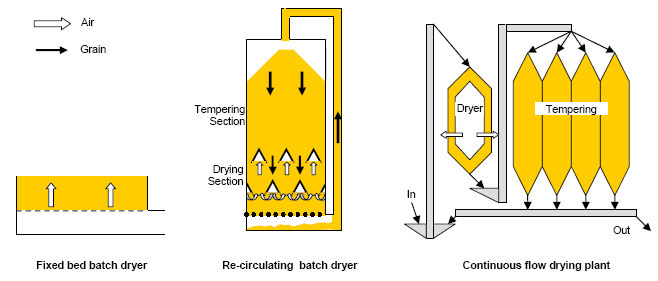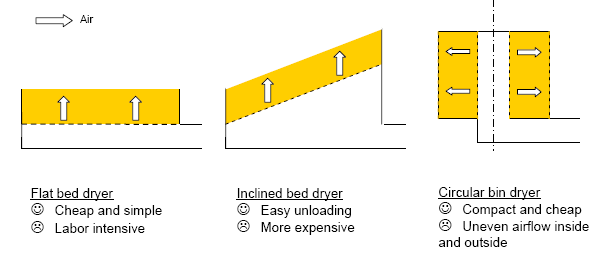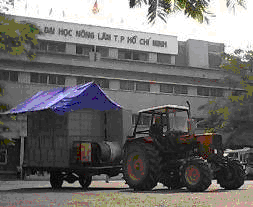Options for "Heated air drying"
The most common way of characterizing heated air drying systems is through the description of the way the grain is being held in or flows through the system. Here we differentiate between fixed bed batch dryers, re-circulating batch dryers, and continuous flow dryers:
 Dryer classification according to crop holding / crop flow
Dryer classification according to crop holding / crop flow
Fixed-bed batch dryers usually have rectangular bins with plenum chamber underneath (flat bed dryer, box dryer, inclined bed dryer) or circular bins with central duct (Vietnamese low-cost dryer).
 Bed configuration of fixed bed batch dryers
Bed configuration of fixed bed batch dryers
The most common fixed bed dryers are flat bed dryers which have a very simple design. Grain is laid out on a perforated screen, and dried by forcing air from below. The air fan that provides the drying air is usually a simple axial flow fan that is powered by a diesel engine or by an electric motor. A kerosene burner or a biomass stove provides drying heat. The capacity of the dryer varies from one to ten tons.
Generally the drying floor is flat although dryers with reclining sections (to facilitate unloading) or vibrating sections (to facilitate stirring) exist as well. The height of the layer is usually 40 cm. The most common smaller dryers have a capacity of one to three tons per day with drying times of six to twelve hours. For drying of paddy in tropical areas, an air temperature of 40−45ºC is normally used with a heater capable of raising the air temperature 10−15ºC above ambient. An air velocity 0.15−0.25 m/s is required and typical fan power requirements are 1.5−2.5 kW /ton of paddy. The efficiency of these dryers as well as the head rice recovery is improved by stirring the grain during drying.
Other fixed bed dryers have a cylindrical duct made out of porous materials with a central duct for drying air delivery. These models save floor area and small scale units can be made out of very cheap materials such as woven bamboo mats thus keeping the dryer affordable for small farmers. However, an inherent problem of this dryer type lies in its circular design because the inner layers of the grain bulk contain less grain than the outer layers. Air velocities and thus drying potential are therefore larger close to the center of the dryer where the drying air enters the grain bulk and the air velocity decreases on its radial path through the grain. At the outlet, the drying rate which is already lower because of adsorbed water is further reduced by the lower specific air volume. This leads to even higher moisture gradients compared to flat bed dryers. Circular bin dryers made out of locally available materials, however, offer very affordable solutions to farm level drying, especially when they are used for ambient air drying with low temperatures where the moisture gradient is minimized.
To reduce the moisture gradient that develops during drying and to eliminate the need for mixing, some manufacturers have introduced devices for reversing the airflow in some fixed bed dryer models. This reduces the moisture gradient and thus improves the quality of the dried paddy but it adds to costs. Compared to the more complicated re-circulating batch dryers this is still a feasible solution where simple design is needed and operator skills are low. Principle (left) and example of a mobile reversible-flow batch dryer (right)
 Principle behind reversible-flow batch dryer
Principle behind reversible-flow batch dryer Mobile reversible-flow batch dryer
Mobile reversible-flow batch dryer







